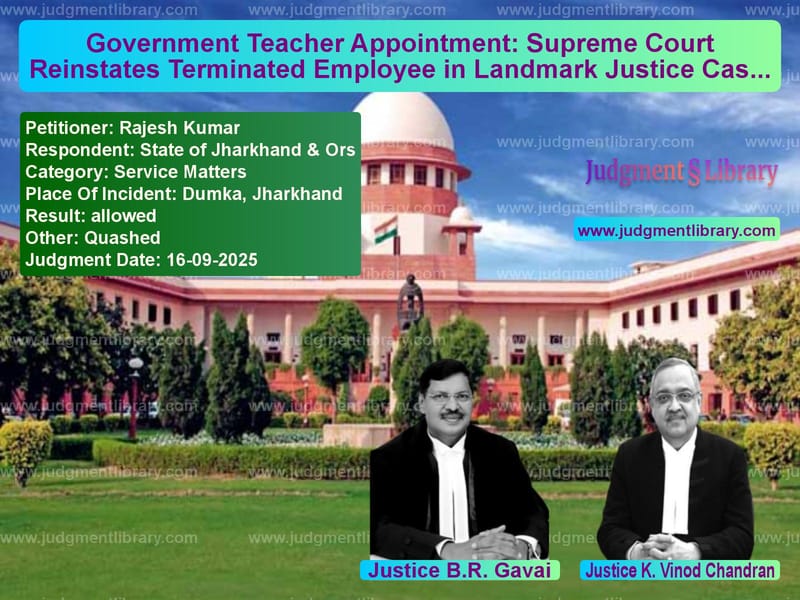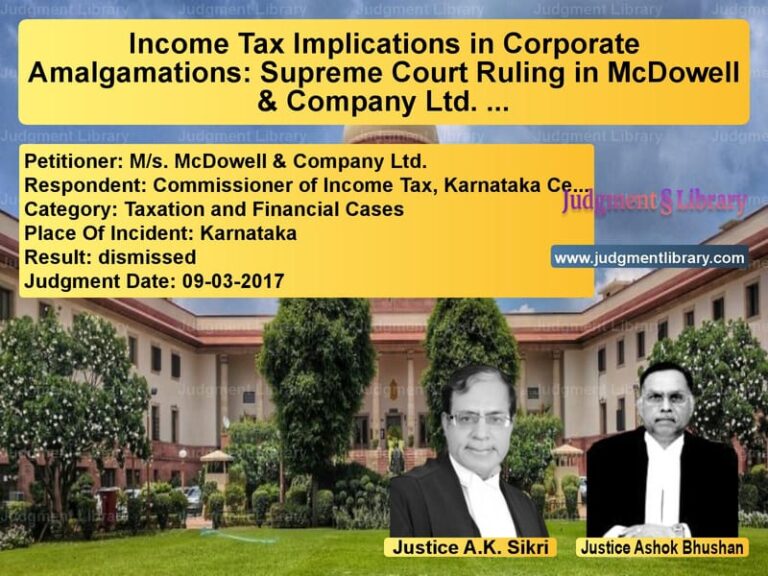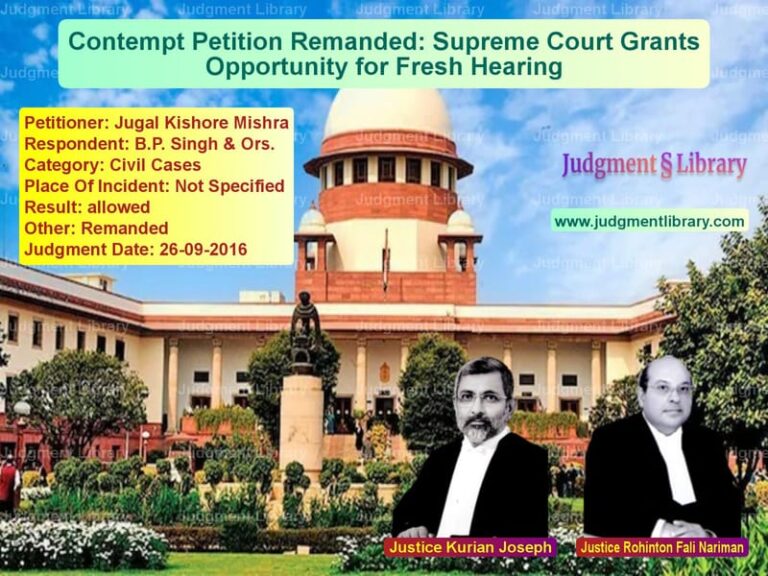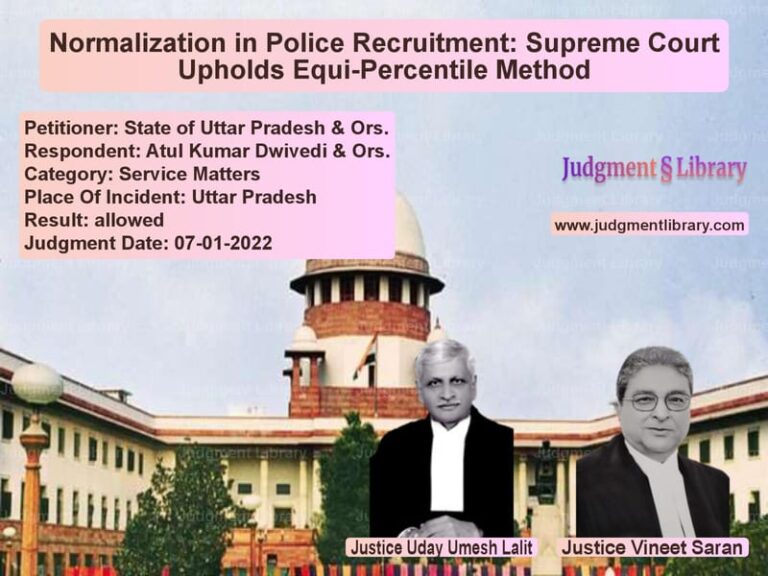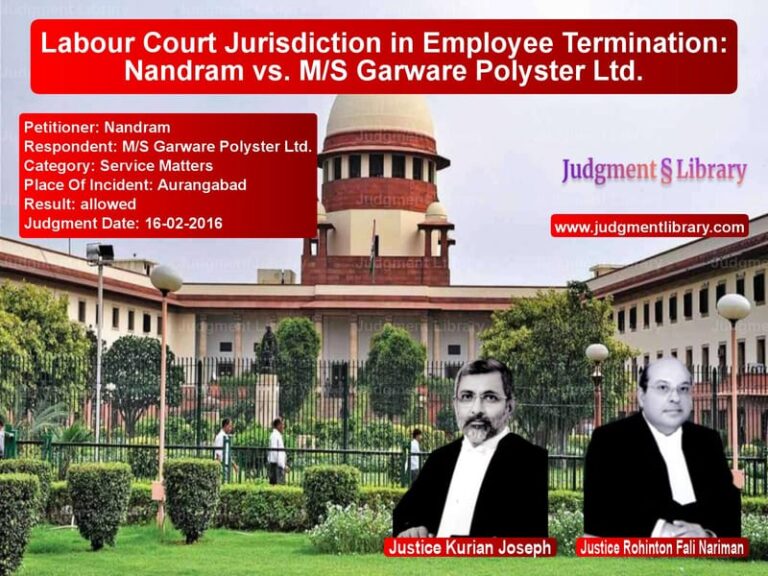Government Teacher Appointment: Supreme Court Reinstates Terminated Employee in Landmark Justice Case
In a remarkable case that highlights the human cost of bureaucratic errors, the Supreme Court of India recently delivered a judgment that reinstated a teacher who had been wrongfully terminated after serving for nearly a year. The case of Rajesh Kumar versus the State of Jharkhand presents a compelling narrative about how ordinary citizens often become victims of administrative mistakes and the judiciary’s role in ensuring justice prevails.
The story begins when the Jharkhand Staff Selection Commission issued an advertisement inviting applications for the post of Trained Graduate Teacher (TGT) in Government Secondary Schools across the state. The advertisement specifically reserved 25 percent of the posts for teachers working in Government Primary Schools of Jharkhand who had a minimum of five years of teaching experience. This reservation was meant to provide career progression opportunities for experienced teachers already serving within the government education system.
Rajesh Kumar, who had been working at St. Teresa Girls Middle School in Dudhani, Dumka since April 2, 2008, believed he qualified for this reserved quota. His appointment had been confirmed by the Director of Primary Education back in May 2009, and he had accumulated more than the required five years of teaching experience. What made his case particularly interesting was that his school, while being a minority institution, was fully government-aided, receiving 100 percent financial support from the government.
Acting on this belief, Kumar submitted his application for the TGT position and even obtained a ‘No Objection Certificate’ from the Office of the District Superintendent of Education in Dumka. The selection process proceeded smoothly, and he was found successful in the competition. His name was recommended for appointment, but when the appointment letter didn’t arrive as expected, he approached the High Court of Jharkhand through a writ petition.
During the pendency of this legal proceeding, something significant happened. The District Education Establishment Committee in Dumka held a meeting on October 19, 2019, where they specifically examined Kumar’s case. The committee found him eligible for the position and directed that an appointment letter be issued to him. Accordingly, on October 24, 2019, he received his appointment letter and joined his new position as TGT on October 26, 2019. With his appointment secured, his earlier writ petition became irrelevant and was disposed of.
However, Kumar’s professional stability was short-lived. After serving for almost a year, he received a shocking termination order dated September 7, 2020. To add insult to injury, another office order dated September 12, 2020, demanded recovery of the entire salary he had drawn during his service period. This sudden reversal left him not only jobless but also facing significant financial liability.
Naturally aggrieved, Kumar approached the High Court again, challenging both his termination and the recovery order. Unfortunately, both the Single Judge and later the Division Bench of the High Court dismissed his petitions, forcing him to approach the Supreme Court as his last resort.
Before the Supreme Court, the arguments from both sides presented a clear legal dilemma. Mr. Adarsh Kumar Tiwari, representing Kumar, made a straightforward argument: “the appellant was working in a 100 per cent Government-Aided Minority School and as such was very much eligible for the 25 per cent quota for the teachers working in Government Elementary Schools.” He emphasized that “it is not in dispute that the appellant possessed the requisite experience and qualification.”
On the other side, Mr. Sudhir Bisla, representing the Jharkhand government, vehemently opposed the appeal. His argument was equally clear: “the aforesaid quota was reserved only for the teachers working in the Government Elementary Schools.” He contended that “the Government Aided Minority School cannot be equated with the Government Elementary Schools.” Based on this technical distinction, he argued that no interference was warranted with the High Court’s orders.
The Supreme Court, in its wisdom, acknowledged the technical validity of the state government’s position. The court observed that “Perusal of the advertisement would clearly reveal that 25 per cent quota was reserved for the teachers working in the Government Elementary Schools having the experience of five years. As such, strictly speaking, the appellant was not eligible to be considered for the said post.”
However, the court recognized that this was no ordinary case of someone trying to secure a position they were clearly ineligible for. The judges noted the peculiar circumstances: “However, in the present case, the Jharkhand Staff Selection Commission has not only found the appellant eligible but also the District Education Establishment Committee, after finding him eligible for the said post in its meeting dated 19th October, 2019, directed to issue the appointment letter to the appellant.”
The court highlighted the grave injustice that would result if Kumar were made to suffer for the mistakes of government authorities: “We find that the appellant has been caught in a peculiar situation. Acting on the order dated 24th October, 2019, he has left his earlier job and now has also been terminated from service in the Government Secondary School.”
In a powerful statement that underscores the principle of justice over technicalities, the court declared: “The appellant cannot be penalized for the mistakes committed by the Jharkhand Staff Selection Commission or the District Education Establishment Committee, Dumka.”
The court meticulously traced the sequence of approvals Kumar had received: “Though, the appellant was not eligible for the said post, the Jharkhand Staff Selection Commission accepted his application as being in order and, upon finding him suitable, selected him for appointment. Not only did the Jharkhand Staff Selection Commission consider him fit for the post but the Office of the District Superintendent of Education, Dumka issued a ‘No Objection Certificate’. Furthermore, the District Education Establishment Committee, Dumka in its meeting held on 19th October, 2019 also found him eligible and as such directed the issuance of an appointment letter to the appellant.”
Based on these compelling circumstances, the Supreme Court allowed the appeal and quashed both the termination order and the recovery order. The court directed that “The appellant shall be reinstated in the Government School forthwith.” While granting him continuity in service for all purposes including terminal benefits, the court exercised balanced judgment by denying him back wages for the period he remained unemployed.
The court set a clear deadline for compliance, ordering that “this order shall be complied with on or prior 1st October, 2025.” However, recognizing the unique facts of the case, the court clarified that “we are passing the aforesaid order in the peculiar facts and circumstances of the present case and it shall not be treated as precedent in any other matter.”
This judgment represents a significant victory for individual justice against bureaucratic rigidity. While acknowledging the technical ineligibility, the Supreme Court prioritized substantive justice, recognizing that when multiple government authorities approve an appointment and an individual acts in good faith on those approvals, they shouldn’t bear the consequences of administrative errors.
The case also raises important questions about the status of teachers in fully government-aided minority schools. While the court didn’t delve deeply into this constitutional aspect, it implicitly acknowledged that there might be a need to reconsider whether teachers in fully funded minority institutions should be treated differently from those in government schools, especially when it comes to career advancement opportunities.
This judgment serves as an important reminder that while rules and regulations are essential for orderly administration, their application must be tempered with justice and fairness. The Supreme Court’s intervention in this case prevented a grave miscarriage of justice where an individual would have suffered professional and financial ruin due to errors completely beyond his control.
The ruling reinforces the principle that citizens who act in good faith on representations made by government authorities should be protected from subsequent reversals of those decisions. It underscores the judiciary’s role as the ultimate guardian of justice, ensuring that technicalities don’t triumph over fairness and that individuals aren’t made to pay the price for institutional failures.
Petitioner Name: Rajesh Kumar.Respondent Name: State of Jharkhand & Ors.Judgment By: Justice B.R. Gavai, Justice K. Vinod Chandran.Place Of Incident: Dumka, Jharkhand.Judgment Date: 16-09-2025.Result: allowed.
Don’t miss out on the full details! Download the complete judgment in PDF format below and gain valuable insights instantly!
Download Judgment: rajesh-kumar-vs-state-of-jharkhand-&-supreme-court-of-india-judgment-dated-16-09-2025.pdf
Directly Download Judgment: Directly download this Judgment
See all petitions in Employment Disputes
See all petitions in Termination Cases
See all petitions in Public Sector Employees
See all petitions in Education Related Cases
See all petitions in Contractual Employment
See all petitions in Judgment by B R Gavai
See all petitions in Judgment by K. Vinod Chandran
See all petitions in allowed
See all petitions in Quashed
See all petitions in supreme court of India judgments September 2025
See all petitions in 2025 judgments
See all posts in Service Matters Category
See all allowed petitions in Service Matters Category
See all Dismissed petitions in Service Matters Category
See all partially allowed petitions in Service Matters Category

